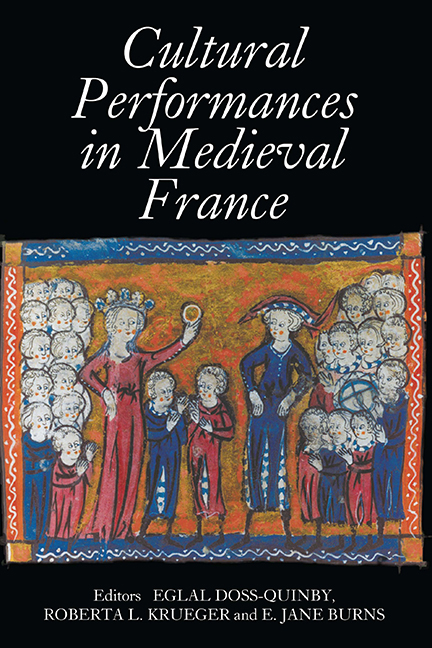Book contents
- Frontmatter
- Contents
- List of Illustrations
- Contributors
- Introduction
- Nancy Freeman Regalado, Curriculum Vitae
- PART I POETIC AND MUSICAL PERFORMANCES
- PART II PERFORMING SEXUAL AND SOCIAL IDENTITIES
- PART III DEVOTIONAL PRACTICE AND TEXTUAL PERFORMANCE
- Performing Vernacular Song in Monastic Culture: The lectio divina in Gautier de Coinci's Miracles de Nostre Dame
- Performative Reading: Experiencing through the Poet's Body in Guillaume de Digulleville's Pèlerinage de Jhesucrist
- The Anglo-Norman Office of the Cross in the Lichtenthal Psalter
- “Laver de ses pechiés une pecheresse royale”: Psalm Collects in an Early Fourteenth-Century Devotional Book
- PART IV PERSUASIVE PERFORMANCES
- PART V RE–ENACTMENTS AND LEGACIES
- Tabula Gratulatoria
- Tabula Gratulatoria
Performative Reading: Experiencing through the Poet's Body in Guillaume de Digulleville's Pèlerinage de Jhesucrist
from PART III - DEVOTIONAL PRACTICE AND TEXTUAL PERFORMANCE
Published online by Cambridge University Press: 24 October 2017
- Frontmatter
- Contents
- List of Illustrations
- Contributors
- Introduction
- Nancy Freeman Regalado, Curriculum Vitae
- PART I POETIC AND MUSICAL PERFORMANCES
- PART II PERFORMING SEXUAL AND SOCIAL IDENTITIES
- PART III DEVOTIONAL PRACTICE AND TEXTUAL PERFORMANCE
- Performing Vernacular Song in Monastic Culture: The lectio divina in Gautier de Coinci's Miracles de Nostre Dame
- Performative Reading: Experiencing through the Poet's Body in Guillaume de Digulleville's Pèlerinage de Jhesucrist
- The Anglo-Norman Office of the Cross in the Lichtenthal Psalter
- “Laver de ses pechiés une pecheresse royale”: Psalm Collects in an Early Fourteenth-Century Devotional Book
- PART IV PERSUASIVE PERFORMANCES
- PART V RE–ENACTMENTS AND LEGACIES
- Tabula Gratulatoria
- Tabula Gratulatoria
Summary
In the introduction to the ground-breaking collection of essays Performing Medieval Narrative, edited by Evelyn Birge Vitz, Nancy Freeman Regalado, and Marilyn Lawrence, the editors describe the focus of their book as “performance in its more interpersonal, dramatic, and physical dimensions (visual, auditory, musical).” The contents indicate a clear adherence to that focus, with sections on medieval performers of narrative, oral performance of books, performability, and the experiences of performers who enact medieval works today. The editors nonetheless provocatively observe that, “Any way in which a narrative is actualized can be said to be a performance. In this sense, even private, silent reading is one kind of narrative performance” (3). And they further suggest how this process of turning silent reading into performance might work: “Readers, too, may assume the role of storyteller, performing narratives silently in their imagination, seeing the story unfold in their mind's eye” (3).
In this essay we take up the challenge of understanding how a reader might “assume the role of storyteller” in a silent reading that did, nonetheless, include visual, auditory, and musical dimensions – a process that we call “performative reading.” We examine one illustrated manuscript version of a poem on the life of Christ. It is one of the texts in Paris, Bibliothèque Sainte-Geneviève 1130, a manuscript dated to about 1370, which contains three long poems written in octosyllabic couplets by the Cistercian monk Guillaume de Digulleville between 1330 and 1358: the Pèlerinage de vie humaine or Pilgrimage of Human Life, an allegory of the Christian life from birth to the moment of death; the Pèlerinage de l’âme or Pilgrimage of the Soul, the story of the soul's judgment after death and its journey through purgatory; and the Pèlerinage de Jésus Christ, the Pilgrimage of Jesus Christ, which treats the Incarnation of the Second Person of the Trinity, the Son, as a pilgrimage to earth. About 11,400 lines in length, the third poem recounts the life of Christ in chronological sequence through his return to heaven and the Assumption of the Virgin. Nearly twenty illustrated manuscripts of this poem survive, and they present a wide range of possibilities for visualizing its narrative.
- Type
- Chapter
- Information
- Cultural Performances in Medieval FranceEssays in Honor of Nancy Freeman Regalado, pp. 135 - 152Publisher: Boydell & BrewerPrint publication year: 2007



